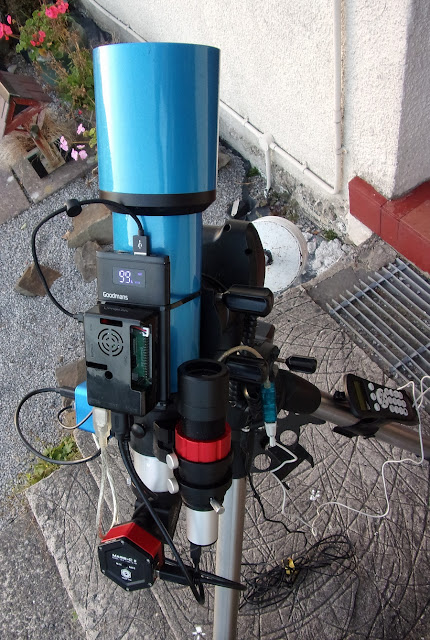Nicola has implemented the advanced functionality in AstroDMx Capture and improved the dark theme rendering for macOS.
Equipment used
A Celestron AVX mount was placed on marks on the concrete base where it is polar aligned if placed carefully. Of course, the accuracy of the polar alignment under these circumstances varies from session to session, depending on the fine placement of the tripod feet on the concrete base.
An ALTAIR STARWAVE 60 ED f/6 Imaging Refractor with field flattener was mounted on an AVX mount. Either a UV/IR cut filter or an Altair Quadband, narrowband filter was placed in the optical train in an Altair magnetic filter holder.
An SVBONY SV605CC OSC 14 bit CMOS camera was attached. An SVBONY SV165 guide-scope fitted with a QHY-5II-M guide camera was mounted on the imaging scope and both the imaging scope and the guide scope were fitted with Kiwi USB powered dew heater strips. The USB power was provided by a mains USB adapter.
The hand controller of the mount was connected to a Raspberry Pi running an INDI server and communicated with the MacBook Air indoors computer, running AstroDMx Capture for macOS, via WiFi.
AstroDMx Capture passed the time, altitude and location coordinates to the hand controller via the INDI server. The hand controller which now contained all of the correct information was set to its previous alignment and was unparked by AstroDMx Capture.
Of course, using the ‘previous alignment’, which could actually have been aligned several sessions previously, means that the alignment is far from perfect. However, the place-solving functionality means that this doesn’t matter at all.
A UV/IR cut filter was placed in the magnetic filter holder.
The mount/scope was sent by AstroDMx Capture to Deneb so that the scope could be focused using a Bahtinov Mask.
The mount/scope pointed in the close vicinity of Deneb. The field was plate solved and the scope was sent to Deneb which was centred. A Bahtinov mask was placed on the imaging scope and the star was brought to focus.
Screenshot of Deneb focused with the aid of a Bahtinov mask
The mount/scope was sent to M31 by AstroDMx Capture. The galaxy was in the field of view but not centred. (It could just as easily have been just outside the field of view, depending on the quality of the alignment).
The field of view was then plate-solved by AstroDMx Capture for macOS
Now M31 was centred in the field of view
AstroDMx Capture for macOS was used to capture 38 x 1m FITS exposures of the Andromeda galaxy.
The images were stacked and partly processed in Deep Sky Stacker and post processed in the Gimp 2.10.
The Andromeda galaxy
The IR/UV cut filter was replaced by an Altair Quadband narrowband filter and the scope was refocused on another star.
AstroDMx Capture for macOS then sent the mount/scope to the Seagull nebula, but a method was used that amounts to a paradigm shift in the composing of images for capture.
It is frequently found that if an extended object such as the Seagull nebula is centred in the field of view by plate solving, the composition is not quite what the imager would have wanted. It is often better to centre the field of view on a selected star, such that the positioning of the extended object is improved.
To this end, Nicola has now implemented the HiP and the HD star catalogues with options to be selected for searching purposes.
If the mount/scope was sent to the star HiP 34234, HD 53755, plate solved and centred:
The Seagull nebula is better placed giving a better composition for imaging
AstroDMx Capture for macOS captured 10 x 6m FITS exposures of the Seagull nebula which were stacked and part processed in Siril and post processed in the Gimp 2.10 and Neat Image.
MacBook Air computer indoors capturing data on the Seagull nebula
The Seagull nebula. IC 2177
The mount/scope was then sent by AstroDMx Capture for macOS to Thor’s Helmet. This object is quite small so the field of view was plate solved and the object was centred in the field of view.
AstroDMx Capture for macOS was used to capture 15 x 6m FITS exposures. The images were stacked and mildly stretched in Siril.
Starnet ++ v2 was used to remove the stars from the image revealing just the nebula and background.
By subtracting the above image from the original image, an image containing just the stars was produced which was then processed slightly to reduce the false colours and prominence of the stars.
The starless image of the nebula was noise-reduced in Neat image and further enhanced in the Gimp 2.10 and PT Photo Editor. Finally the processed star image was added to the processed nebula image to reconstruct the field of view showing Thor’s Helmet in the starfield.
AstroDMx Capture for macOS worked well with the equipment used and with the advanced functionality. The procedure for centering a field of view on a star rather than on an extended object demonstrated that this can be a superior way of positioning an extended object in the field of view.
.png)





.png)



.png)
.png)

.png)

.png)
.png)
.png)
.png)

.png)


























